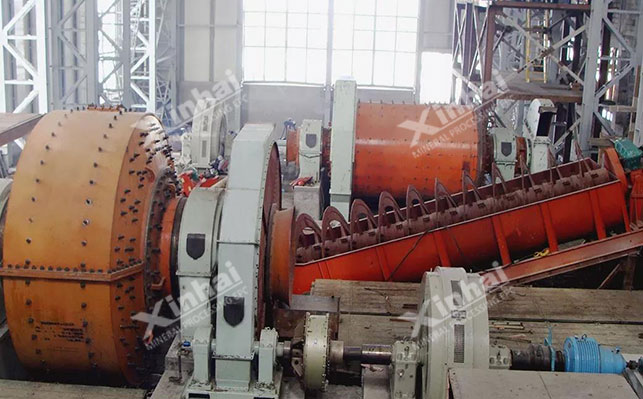Crushing and grinding is a key process before separation, and its cost accounts for 50%-60% of the ore dressing plant, and energy and steel consumption account for 60%-70%. Traditional crushing and grinding processes mostly use crushers + ball mills to complete crushing and grinding operations. This combination has been very mature after many years of application. However, it has disadvantages such as long process and complex equipment. The semi-autogenous grinding process can alleviate these problems and has become a more widely used crushing and grinding process in recent years.
Principle: The semi-autogenous grinding process has the functions of both crushing and coarse grinding. The ore itself is the main grinding medium, supplemented by an appropriate amount of steel balls. The difference between the semi-autogenous grinding process and the ball milling process is that it can crush the ore according to the dissociation plane, and the monomer dissociation degree is higher.
Process flow: There are three commonly used processes for the semi-autogenous grinding process:
(1) Single-stage semi-autogenous grinding process (SA): simple and easy to manage, but high energy consumption, weak fine grinding ability, and need to understand the properties of the ore.
(2) Semi-autogenous grinding + ball milling process (SAB process): After the ore is coarsely crushed, it enters the semi-autogenous mill and then passes through the vibrating screen, cyclone + ball milling process. It is suitable for non-ferrous metal and gold mines with medium or soft ores, but is greatly affected by the crushing speed of stubborn rocks.
(3) Semi-autogenous grinding + ball milling + crushing process (SABC process): After the ore is crushed, it enters the semi-autogenous mill, replacing multiple operations. It has strong adaptability to ores and is widely used.

(1) Advantages:
Short process, less equipment, small footprint, low investment and operating costs, easy to manage and automatically control.
It can reduce over-crushing, improve product particle size and pulp properties, has strong adaptability to high-viscosity ores, has a large crushing ratio, and promotes mineral dissociation.
(2) Disadvantages:
Sensitive to the properties of the original ore, long commissioning cycle, complex operation and control, low equipment operation rate and grinding efficiency, high power consumption, short lining plate life, and easy damage to steel balls.
The semi-autogenous grinding process is not suitable for all ores, but is suitable for ores with a Pugh hardness of f=6-12. At the same time, the feed particle size, coarse particle content and ore hardness must also be considered.
Since the birth of the first wet autogenous mill in 1932, the world's largest semi-autogenous mill is a Φ12.19×10.97m mill produced by a heavy industry manufacturer and used in the Sino Iron Ore Concentrator in Australia.
The top five countries in terms of application are the United States, Russia, South Africa, Canada and Australia, with more than 1,200 (semi) autogenous mills of various types used in metal mines.
The autogenous grinding mill produced by Xinhai Mining has two functions: crushing and grinding. It can replace the second and third stage crushing, screening, rod mill or ball mill, part or even all of the crushing and grinding functions. It has the characteristics of low energy consumption, less auxiliary equipment, stable product strength, and automation.
Xinhai Semi-autogenous Grinding Mill has a high crushing ratio, which can reach 3000-4000 (feed 300-400 mm, output product less than 0.1 mm). It can achieve autogenous grinding without adding any grinding media, and a small amount of steel balls can be appropriately added, usually accounting for 2-3% of the effective volume of the autogenous grinding mill.
With the continuous development of crushing and grinding technology, semi-autogenous grinding technology is increasingly used in ore dressing plants. Semi-autogenous grinding mills can replace part of the crushing and part of the grinding operations. It can be said that one machine has multiple uses, which simplifies the crushing and grinding process, making the crushing and grinding operation more efficient and cost-effective, and is the inevitable development direction in the future.